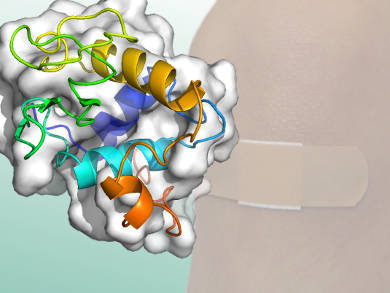Wound infection is a common but unfavorable complication of wound healing, as it delays the healing process and bears high risks for patients. Early detection of infections is extremely desirable, but current tests are very complex, require special equipment, and cannot be performed in home care.
Andrea Heinzle and colleagues, Austrian Centre of Industrial Biotechnology, Graz, Austria, have demonstrated that lysozyme (pictured) is increased in wound fluids during an infection. Lysozyme is an enzyme long known in medicine, as it hydrolyzes parts of bacterial cell walls protecting the human body from infections.
Based on this finding, the team developed a patch to quickly detect wond infection consisting of two layers of membranes: The first layer is a size exclusion membrane, which allows small fragments resulting from lysozyme activity on bacterial cell walls to pass through. These molecules are then captured in the second layer, an anion-exchanging diethylaminoethyl (DEAE)-cellulose membrane. Here a visible color change is induced by interaction with the hydrolysis products. This color change of the patch is the signal to start antibiotic treatment to fight wound infection.
- Lysozyme-Responsive Polymer Systems for Detection of Infection,
Doris Schiffer, Vanessa Verient, Daniel Luschnig, Miriam H.E. Blokhuis-Arkes, J.v.d. Palen, Clemens Gamerith, Michael Burnet, Eva Sigl, Andrea Heinzle, Georg M. Guebitz,
Eng. Life Sci. 2015.
DOI: 10.1002/elsc.201400145



